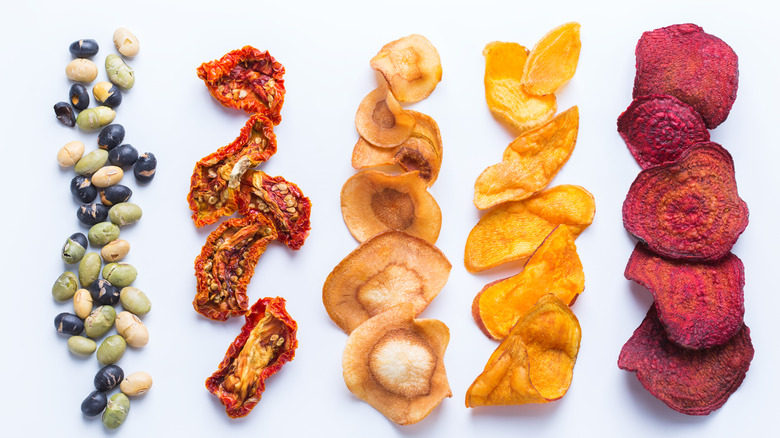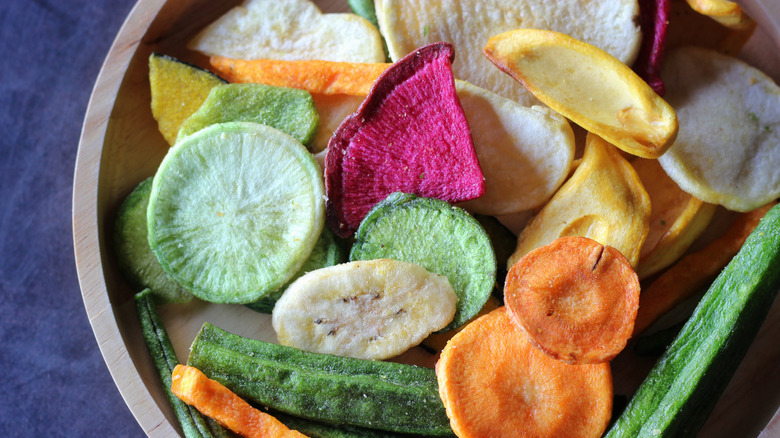Dehydrate Canned Veggies For An On-The-Go Hiking Snack And Thanks Us Later
Picture this: You're out on a hike and just crested a challenging climb. You catch your breath and perch on top of a flat rock to soak in a beautiful mountain view. As the breeze whistles through the trees and the warm sun greets your face, you're left wondering about the one thing that could make this moment even better — food! If there's one thing that you'll definitely need while hiking, it's a tasty snack to enjoy along the way.
Trail food is an essential component of any hike. Snacks help fuel your activity with proper nutrition and deliver a nice pick-me-up when the trail gets tough. For something both tasty and filled with nutrients, look no further than a few handfuls of dehydrated veggies. Lightweight, tasty, and nourishing, these dehydrated delights are the perfect trail companion. Using canned vegetables will make the process even easier, and you can even make them yourself. Whether you're a casual hiker or a serious mountaineer, consider packing some dehydrated veggies for your next outdoor adventure.
Canned veggies to the rescue
The best part about snacking on dehydrated vegetables? You can make them yourself. Start by sourcing some of your favorite veggies. You can make a vegetable-style trail mix by dehydrating small veggies like beans, corn, and peppers. If you'd like a snack with more of a crunch, use foods that can be cut thin and crisped up — like potatoes and even leafy greens such as kale.
Canned vegetables work particularly well for dehydration because they require minimal preparation. To dehydrate successfully, many vegetables need a round of steaming or blanching. Steaming helps some veggies, like carrots, green beans, and broccoli, retain their bold colors, and blanching softens the vegetables' outer layers so that moisture can escape in the dehydrator. Canned veggies have already been cooked and don't require either of these processes. Plus, they have a higher sodium concentration. This salt content, which is introduced as part of the canning preservation process, doubles as a nice seasoning for your hiking snacks. Using canned vegetables will allow you to skip the steaming, blanching, and seasoning steps, ultimately saving a ton of prep time in the kitchen.
The dehydration process
When you're ready to load the dehydrator, make sure to drain the canned juices. Also, keep in mind that foods will shrink during the process. In fact, these appliances can reduce foods to ¼ of their former size. To accommodate for shrinkage, pour your canned vegetables into measuring cups so that you can calculate the approximate size of your final hiking snack. If you're looking for a hot meal in the backcountry, you can always rehydrate your dried foods with a bit of boiling water, returning them to their original size.
Vegetables are typically dehydrated between 135 and 145 degrees Fahrenheit. Higher temperatures will quickly dry and harden the outside of the vegetable, preventing the internal water content from escaping. Cooking times will vary depending on the number of trays and the size of the cut veggies. Smaller veggies may take only six hours, while larger pieces might require nearly 12 hours of dehydration. Luckily, dehydrators can hum quietly along in the background while you go about your day.
Although you can dry foods without a dehydrator, this appliance offers one of the most convenient methods to do so. Home models will range in price from less than $50 to over $500. Typically, pricier appliances will have more capacity and offer additional tools, like automatic timers and more temperature options. However, a basic dehydrator will still get the job done and is a great way to dip your toe into the world of dehydration.


